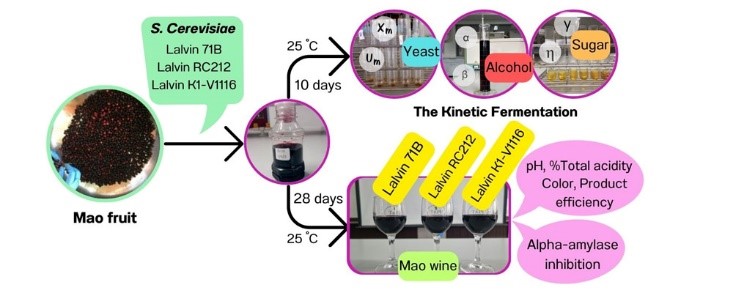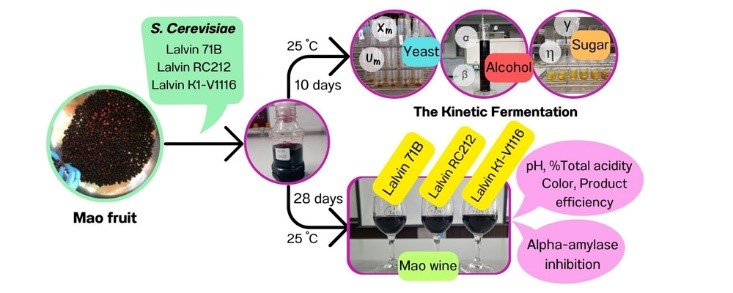Fermentation Kinetic and Alpha-Amylase Inhibition Studies of Mao Wine Fermented by Three Commercial Saccharomyces cerevisiae Yeasts
DOI:
https://doi.org/10.48048/tis.2024.7462Keywords:
Mao, Wine, S. cerevisiae, Fermentation kinetics, Yeast growth, Alcohol production, Reducing sugar consumption, Alpha-amylase inhibition, DiabetesAbstract
Mao wine is produced from mao (Antidesma thwaitesianum) and is a local beverage promoting Sakon Nakhon province, Thailand. Understanding the fermentation process is necessary in order to enhance the quality of mao wine products. This study aims to examine the kinetics of mao wine fermentation using 3 commercial types of Saccharomyces cerevisiae yeasts, namely Lalvin 71B, Lalvin RC212 and Lalvin K1-V1116, with an initial pH of 3.4, a sweetness of 22 % Brix and a yeast concentration of 0.4 g L–1 in controlled conditions at 25 °C for 10 days. The results revealed that the kinetic models, including logistic, Luedeking-Piret and modified Luedeking-Piret equations, are appropriate for analyzing the kinetics of yeast growth, alcohol production and reducing sugar, respectively. Lalvin K1-V1116 yeast yielded the highest capacity for alcohol production (~113 g L–1), sugar-to-alcohol conversion (45 % conversion), and product efficiency (88 %), indicating its suitability for mao wine production. Furthermore, the investigation of the alpha-amylase inhibitory activity revealed that the IC50 values of mao wine samples were 2.88 - 4.78 mg mL–1, which were roughly 410 - 680 times greater than those of acarbose. These findings revealed the low efficacy of mao wine in inhibiting alpha-amylase activity. Nevertheless, a decrease in the level of inhibition may result in a decreased likelihood of side effects or undesirable reactions. This treatment is especially beneficial for people who have medication sensitivities. Additional research is required in order to substantiate its applicability in the management of type 2 diabetes.
HIGHLIGHTS
- Mao wines were produced by 3 commercial cerevisiae yeast strains
- Lalvin K1-V1116 yeast exhibits the highest capacity in converting sugar to alcohol
- Lalvin K1-V1116 is the most suitable yeast for making mao wine
- The chosen kinetic models are appropriate for kinetic studies of fermentation process
- The efficacy of Mao wine in inhibiting the activity of alpha-amylase is quite low
GRAPHICAL ABSTRACT

Downloads
Metrics
References
W Suravanichnirachorn, V Haruthaithanasan, S Suwonsichon, U Sukatta, T Maneeboon and W Chantrapornchai. Effect of carrier type and concentration on the properties, anthocyanins and antioxidant activity of freeze-dried mao (Antidesma bunius (L.) Spreng) powders. Agr. Nat. Resour. 2018; 52, 354-60.
T Rosruen, V Vadhanasindhu and P Phuwapraisirisan. Anthocyanin and polyphenol contents of Antidesma thwaitesianum Müll. Arg. berry juice being stabilized by protein matrices. Int. J. Agr. Tech. 2021; 17, 685-96.
O Krongyut and K Sutthanut. Phenolic profile, antioxidant activity, and anti-obesogenic bioactivity of Mao Luang fruits (Antidesma bunius L.). Molecules 2019; 24, 4109.
C Ngamlerst, A Udomkasemsab, R Kongkachuichai, K Kwanbunjan, C Chupeerach and P Prangthip. The potential of antioxidant-rich Maoberry (Antidesma bunius) extract on fat metabolism in liver tissues of rats fed a high-fat diet. BMC Compl. Alternative Med. 2019; 19, 294.
ML Castro-Acosta, L Smith, RJ Miller, DI McCarthy, JA Farrimond and WL Hall. Drinks containing anthocyanin-rich blackcurrant extract decrease postprandial blood glucose, insulin and incretin concentrations. J. Nutr. Biochem. 2016; 38, 154-61.
P Aksornchu, N Chamnansilpa, S Adisakwattana, T Thilavech, C Choosak, M Marnpae, K Mäkynen, W Dahlan and S Ngamukote. Inhibitory effect of Antidesma bunius fruit extract on carbohydrate digestive enzymes activity and protein glycation in vitro. Antioxidants 2021; 10, 32.
CMN Picot, AH Subratty and MF Mahomoodally. Inhibitory potential of five traditionally used native antidiabetic medicinal plants on α-amylase, α-glucosidase, glucose entrapment, and amylolysis kinetics in vitro. Adv. Pharmacol. Sci. 2014; 2014, 739834.
N Scrimgeour, S Nordestgaard, NDR Lloyd and EN Wilkes. Exploring the effect of elevated storage temperature on wine composition. Aust. J. Grape Wine Res. 2015; 21, 713-22.
RS Jackson. Innovations in winemaking. In: MR Kosseva, VK Joshi and PS Panesar (Eds.). Science and technology of fruit wine production. Academic Press, Massachusetts, 2017, p. 617-62.
KV Miller and DE Block. A review of wine fermentation process modeling. J. Food Eng. 2020; 273, 109783.
D Wang, Y Xu, J Hu and G Zhao. Fermentation kinetics of different sugars by apple wine yeast Saccharomyces cerevisiae. J. Inst. Brewing 2004; 110, 340-46.
X Li, LJ Chan, B Yu, P Curran and SQ Liu. Fermentation of three varieties of mango juices with a mixture of Saccharomyces cerevisiae and Williopsis saturnus var. mrakii. Int. J. Food Microbiol. 2012; 158, 28-35.
R Boulton. The prediction of fermentation behavior by a kinetic model. Am. J. Enol. Viticult. 1980; 31, 40-5.
I Caro, L Perez and D Cantero. Development of a kinetic model for the alcoholic fermentation of must. Biotechnol. Bioeng. 1991; 38, 742-8.
G Zhang, X Li, W Chen, P Chen, X Jin, W Chen and H Chen. Organic acid content, antioxidant capacity, and fermentation kinetics of matured coconut (Cocos nucifera) water fermented by Saccharomyces cerevisiae D254. Int. J. Food Eng. 2018; 14, 20170331.
MR Marín. Alcoholic fermentation modelling: Current state and perspectives. Am. J. Enol. Viticult. 1999; 50, 166-78.
PC Setford, DW Jeffery, PR Grbin and RA Muhlack. Mathematical modelling of anthocyanin mass transfer to predict extraction in simulated red wine fermentation scenarios. Food Res. Int. 2019; 121, 705-13.
RA Tindal, DW Jeffery and RA Muhlack. Mathematical modelling to enhance winemaking efficiency: A review of red wine colour and polyphenol extraction and evolution. Aust. J. Grape Wine Res. 2021; 27, 219-33.
JF Rice, TR Sullivan and JR Helbert. A rapid method for the determination of yeast dry weight concentration. J. Am. Soc. Brewing Chem. 1980; 38, 142-5.
HS Son, YS Hong, WM Park, MA Yu and CH Lee. A novel approach for estimating sugar and alcohol concentrations in wines using refractometer and hydrometer. J. Food Sci. 2009; 74, C106-C111.
P Zhang, H Hai, D Sun, W Yuan, W Liu, R Ding, M Teng, L Ma, J Tian and C Chen. A high throughput method for total alcohol determination in fermentation broths. BMC Biotechnol. 2019; 19, 30.
OriginLab Corporation. Origin (Pro), version 2018. OriginLab Corporation, Massachusetts, 2018.
RM Alvarenga, AG Carrara, CM Silva and ES Oliveira. Potential application of Saccharomyces cerevisiae strains for the fermentation of banana pulp. Afr. J. Biotechnol. 2011; 10, 3608-15.
F Ayala, JF Echávarri and AI Negueruela. A new simplified method for measuring the color of wines: I. red and rosé wines. Am. J. Enol. Viticult. 1997; 48, 357-63.
FL Han, WN Zhang, OH Pan, CR Zheng, HY Chen and CQ Duan. Principal component regression analysis of the relation between CIELAB color and monomeric anthocyanins in young cabernet sauvignon wines. Molecules 2008; 13, 2859-70.
HC Lu, Y Wang, CF Cheng, W Chen, F He, CQ Duan and J Wang. Distal leaf removal made balanced source-sink vines, delayed ripening, and increased flavonol composition in Cabernet Sauvignon grapes and wines in the semi-arid Xinjiang. Food Chem. 2022; 366, 130582.
P Bernfeld. Amylases, alpha and beta. In: Methods in Enzymology. Academic Press, Cambridge, Massachusetts, 1955, p. 149-58.
A Kawee-Ai, AT Kim and SM Kim. Inhibitory activities of microalgal fucoxanthin against α-amylase, α-glucosidase, and glucose oxidase in 3T3-L1 cells linked to type 2 diabetes. J. Oceanol. Limnol. 2019; 37, 928-37.
AS Gupthar, S Bhattacharya and TK Basu. Evaluation of the maximum specific growth rate of a yeast indicating non-linear growth trends in batch culture. World J. Microbiol. Biotechnol. 2000; 16, 613-6.
L Cai, W Wang, J Tong, L Fang, X He, Q Xue and Y Li. Changes of bioactive substances in lactic acid bacteria and yeasts fermented kiwifruit extract during the fermentation. LWT 2022; 164, 113629.
R Boulton. The copigmentation of anthocyanins and its role in the color of red wine: A critical review. Am. J. Enol. Viticult. 2001; 52, 67-87.
MA Varo, MP Serratosa, J Martín-Gómez, L Moyano and J Mérida. Influence of fermentation time on the phenolic compounds, vitamin C, color and antioxidant activity in the winemaking process of blueberry (Vaccinium corymbosum) wine obtained by maceration. Molecules 2022; 27, 7744.

Downloads
Published
How to Cite
Issue
Section
License
Copyright (c) 2023 Walailak University

This work is licensed under a Creative Commons Attribution-NonCommercial-NoDerivatives 4.0 International License.






